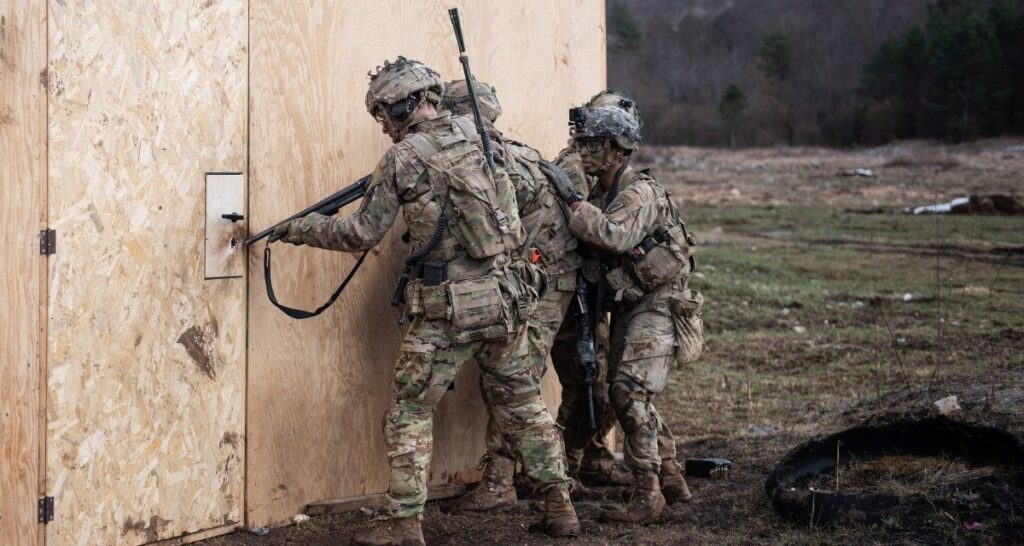Close quarter battle (CQB) tactics and equipment are essential for military units engaging in urban warfare. This article explores the strategies and tools used in CQB scenarios to neutralize threats and protect friendly forces. CQB tactics include room clearing, breaching, fire and movement, stealth, and adaptability. Soldiers utilize specialized equipment such as close-quarter battle rifles, flashlights and laser sights, night-vision devices, body armor and helmets, communication systems, and non-lethal weapons. With urban areas becoming common battlegrounds, the development of advanced CQB tactics and equipment remains crucial for military operations in modern warfare.
Close Quarter Battle (CQB) Tactics and Equipment: Tools for Urban Warfare
Introduction
In modern warfare, urban areas have become a common battleground. The complexity and dynamics of close quarter battle (CQB) in urban environments pose unique challenges for military units. To effectively navigate and neutralize threats in such scenarios, specialized tactics and equipment are required. This article will delve into CQB tactics and the equipment used by military forces in urban warfare.
CQB Tactics
Close quarter battle tactics refer to the techniques and strategies employed by military units when engaged in combat in confined spaces, such as buildings, alleys, and streets. The objective of CQB is to neutralize enemy forces while minimizing collateral damage and protecting friendly forces.
1. Room Clearing: One of the fundamental CQB tactics is room clearing. This involves entering a room or building and systematically clearing it. Teams move swiftly to eliminate any threats, while maintaining situational awareness to minimize risks.
2. Breaching: Breaching tactics are used to gain access to a structure quickly. This can be achieved through techniques such as forced entry or the use of explosive charges to breach doors or walls.
3. Fire and Movement: Fire and movement is a standard infantry tactic that is adapted for CQB. Small teams provide covering fire while another team moves to a better position. This allows for an effective and coordinated assault on the enemy.
4. Stealth: Stealth is crucial in CQB scenarios. Soldiers minimize noise and light signatures to maintain the element of surprise. The use of silenced weapons and hand signals during communication is common.
5. Adaptability: CQB tactics require constant adaptation based on the environment and the intelligence received. Teams must be flexible in their approach to effectively engage in urban warfare.
CQB Equipment
CQB equipment is specifically designed to enhance the effectiveness and survivability of military units in urban combat. Here are some essential tools used by soldiers in CQB:
1. Close-Quarter Battle Rifle: CQB rifles are typically shorter in length compared to standard rifles, allowing for ease of maneuverability in tight spaces. These rifles often have collapsible stocks and reduced barrel lengths to enhance the soldier’s agility.
2. Flashlights and Laser Sights: Illumination tools, such as flashlights and laser sights, are vital for target acquisition and identification, especially in low-light environments. They assist soldiers in maintaining visibility while minimizing the risk of exposing themselves to enemy fire.
3. Night-vision Devices: Night-vision devices, such as goggles or scopes, enable soldiers to see in complete darkness. In urban environments, where visibility may be limited, night-vision devices significantly enhance situational awareness and provide a clear advantage during nighttime operations.
4. Body Armor and Helmets: Body armor and helmets provide essential protection to soldiers in close-quarter battle scenarios. These equipment pieces are designed to withstand ballistic threats and shrapnel, reducing the risk of injury to the combatants.
5. Communication Systems: Effective communication is crucial in CQB operations. Soldiers utilize radio systems and earpieces to maintain constant contact with their team members, providing real-time information, coordinating movements, and sharing situational updates.
6. Non-lethal Weapons: Non-lethal weapons are used in CQB situations to neutralize threats without causing permanent harm. Equipment such as pepper spray, stun guns, and rubber projectiles allow soldiers to incapacitate adversaries while minimizing civilian casualties.
Conclusion
CQB tactics and equipment play a vital role in modern urban warfare scenarios. Military units need to be well-trained in close-quarter battle techniques and equipped with specialized gear to effectively engage enemy forces in confined spaces. As urban areas continue to be significant theaters of conflict, the development of further advancements in CQB tactics and equipment will remain critical for military operations.
